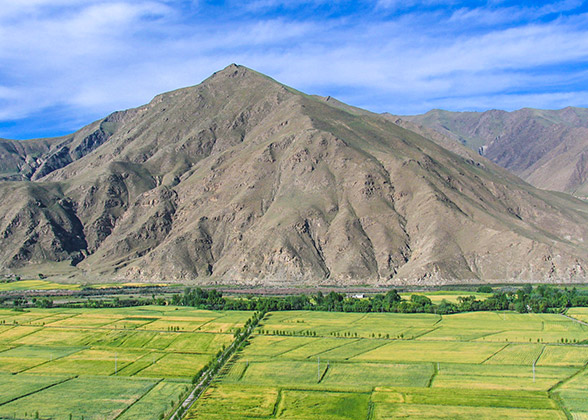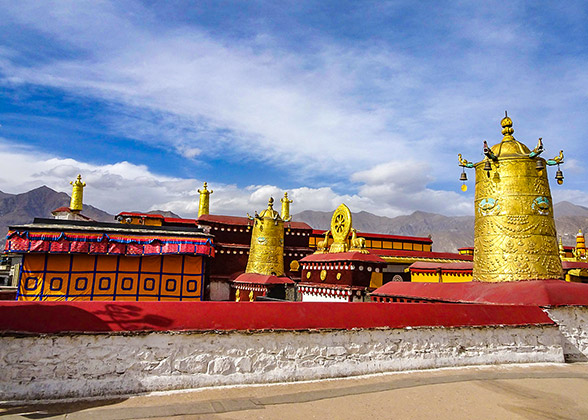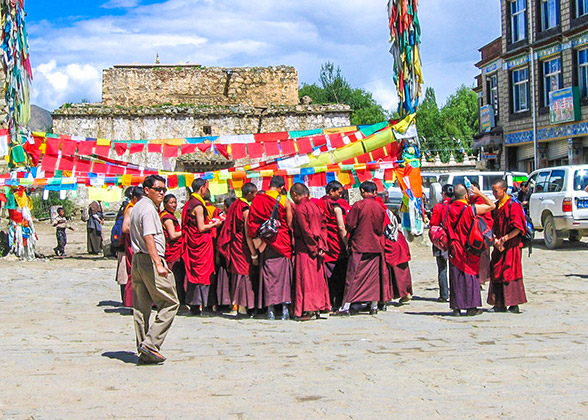Ultimate Guide to Lhasa - Tsetang Hiking
Though this Lhasa to Tsetang hiking route is popular, the walk is a challenge and the altitude gains are higher than those often recommended. We recommend to start hiking at 3,800 meters (12,470 feet) from the Ganden Monastery and head toward the Samye Monastery. The highest pass to cross is Shug-La Pass at 5,266 meters (17,277 feet). This pilgrimage route is well used by Tibetans, who find it convenient for combining a visit to Ganden Monastery (the principal monastery of the Gelugpa) with a reasonably direct but hard walk to Samye Monastery (Tibet's first monastery). With a slow amble, this trek is fulfilling and pleasant.
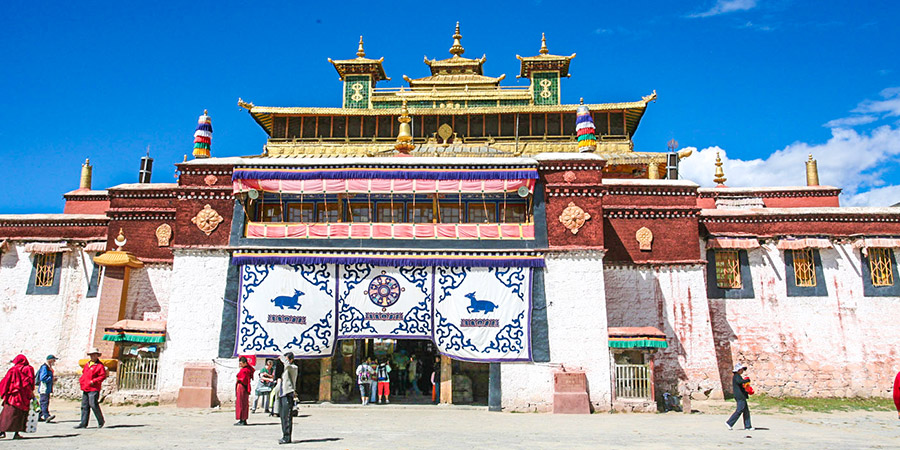 |
| Samye Monastery |
6-Day Hiking Itinerary from Lhasa to Tsetang
1st Day: Lhasa City – Ganden Monastery – Heibu Village (a stay overnight)
 |
| Tibetan in Ganden Monastery |
From the Ganden Monastery, start your trek along a path in front of the monastery to climb up the mountain. This will be a really arduous day, as you might have not acclimated yourself to the 4000m's altitude (12,120 feet). In about 3 hours, you should reach Heibu village; lots of jubilant climbers might follow you. Find a simple lodge and stay overnight in this small village.
2nd Day: Heibu Village – Shug-La Pass – Downhill – Tsotup Chu Valley
On the second day, an even more challenging hike will cover Shug-La Pass (5,256m or 17,244 feet) and then descend downhill. The most severe part is the stone path before you reach the Shug-La Pass. Here violent gusts of wind can impede your progress and short of breath. After the steep path along the Shug-La Pass, the route continues to follow the cairn-lined trail. As you gradually descend, you will pass along a dangerous rough road; take special care to avoid falling down from the cliff. As the path continues, you will see a splendid stream, Tsotup Chu Valley, a long stream winding along the valley floor. Nomadic herdsmen with their herds of yak, goats and sheep dot the landscape. You are recommended to camp near the stream crossing.
|
|
3rd Day: Tsotup Chu Valley
On the third day, from the Tsotup Chu Valley, you can follow a small tributary flowing from the southwest. The route follows steeply upwards for 30 minutes, reaching a large basin. The terrain from here to the Chitu-La Pass (5,228m / 17,152 feet) is not particularly difficult and is marked by several cairns. There is nothing at the peak of this hill other than the big black rocks, but you will be surprised by the snow-white lake cradled amongst the scree. A short but steep descent leads you into this basin containing three small lakes. Often, the trail is not too clearly marked and passes seasonal campsites before finally reaching the valley floor.
You might pick up some wood and make a fire, to warm some food. There is a patch of grassland in the col, which is a frequently used camping place. You can find it easily by walking alongside the stream.
4th Day: Tsotup Chu Valley – Gen Do – Chantan Village – Yamalung Valley - Yamalung Hermitage
On the fourth day, you will follow a wide and easy trail that is much better than the tortuous routes of your two previous days. Proceed through a forest of shrubs and rhododendrons for three hours, and then amble through a series of meadows before reaching Gen Do, a ruined stone structure. The forest thins rapidly and you will reach Chantan, the first permanent village after Heibu village. In 30-40 minutes you will arrive at the turn off for Yamalung Valley. The Yamalung Hermitage is a further hour long steep climb from the valley floor.
5th Day: Yamalung Valley - Yamalung Hermitage – Nyango – Wango – Pisha – Samye Monastery
On the fifth day, after a trek of some four hours, you will reach the Samye Monastery, the first temple to be built in Tibet and the first to be complete with the three Buddhist jewels of Buddha, Dharma and Sangha; the admission fee is CNY44. Your journey will have commenced from Yamalung Valley, passing the villages of Nyango, Wango and Pisha. From Pisha, the entire lower valley of Samye Monastery and the golden spires of Samye Monastery come into view.
Today, you can stay in the monastery hostel, which costs CNY30 for a quad room. Or there are good hotels not far from the monastery and the prices range from CNY200 – 400 per night for a person. Alternatively, you can camp in the forest, which is in the back yard of the monastery. There are many Tibetan restaurants and Sichuan restaurants outside the East entrance of the monastery and you can treat yourself a good dinner today.
|
|
6th Day: Samye Monastery – Lhasa
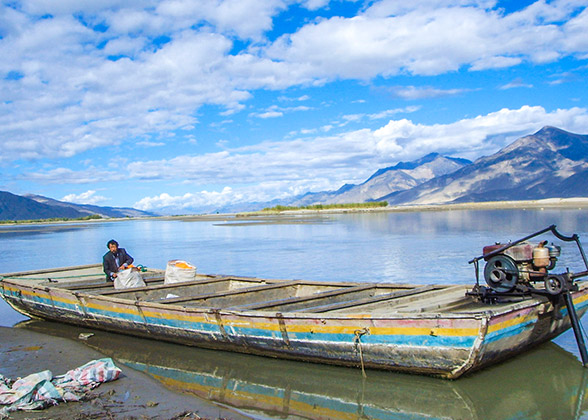 |
| Samye Ferry Port |
1. If you want to return to Lhasa, you can take bus at 14:00 p.m. or 14:30 p.m. departing from Samye Monastery and the price is CNY60 per person. You will get to Lhasa in 2 hours.
2. Should you wish to extend your trekking tour, you might take a cargo truck for the 40 minute ride to the ferry terminal (CNY3 per person) and take a ferry for the one and a half hour crossing to Yarlung Tsangpo River(CN10 per person). Upon arrival in the Samye ferry port and take another regular bus to Tsetang. Or, from Samye ferry port, you can take a bus to Lhasa Xijiao Station, which costs CNY 27 person and takes you about 3 hours.
We suggest you pay a visit to Tibet's oldest building - the Yongbulakhang (the admission fee is CNY30.00) after arrival in Tsetang. Sacred texts are said to have miraculously fallen on the palace roof, heralding the first appearance of Buddhism in Tibet. After a one night stay in Tsetang, you can take an airport shuttle bus to Gonggar Airport to catch the flight to Beijing or to Kathmandu.
Recommended Tours
- Last updated on Oct. 21, 2024 by Zoey Gong -
